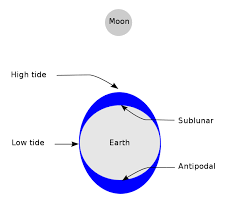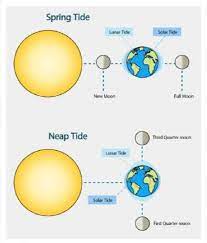The ocean is a constantly changing entity, shaped by the forces of wind, temperature, and the gravitational pull of the moon and the sun. One of the most visible and predictable of these forces is the oceanic tide, a rhythmic rise and fall of sea level that occurs roughly every 12 hours and 25 minutes. In this article, we’ll explore the causes and characteristics of oceanic tides and their impact on the world’s oceans.

Table of Contents
What are Oceanic Tides?
Oceanic tides are the periodic rise and fall of sea level caused by the gravitational pull of the moon and the sun on the Earth’s water. Tides are created by the friction between the ocean and the ocean floor, causing water to move towards the shore in a slow, rhythmic cycle. The result of this cycle is a predictable pattern of high and low tides that occur every 12 hours and 25 minutes.
There are two main types of oceanic tides: spring tides and neap tides. Spring tides occur when the moon and the sun are in alignment, causing the gravitational pull of these two celestial bodies to combine and create a larger tidal bulge.
Neap tides occur when the moon and the sun are at right angles to one another, reducing the gravitational pull and creating a smaller tidal bulge.

What Causes Oceanic Tides?
Oceanic tides are caused by the gravitational pull of the moon and the sun on the Earth’s water. The gravitational pull of these two celestial bodies creates a tidal bulge in the ocean, causing the water to move towards the shore in a slow, rhythmic cycle.
The moon has the largest effect on oceanic tides, as it is much closer to the Earth than the sun and its gravitational pull is therefore stronger. However, the sun also has an impact on tides, as its gravitational pull combines with that of the moon to create spring tides.
In addition to the gravitational pull of the moon and the sun, oceanic tides are also influenced by other factors such as wind patterns, water density, and the shape of the ocean floor. These factors can cause variations in the height and timing of tides, creating unique tidal patterns in different regions of the world.
Impact of Oceanic Tides on the Ocean and Coastline
Oceanic tides play a crucial role in shaping the world’s oceans and coastlines. The constant rise and fall of sea level creates currents and waves that transport sediment and nutrients along the shore, helping to build and reshape coastlines over time.
Tides also play a crucial role in the mixing of ocean water, as the rise and fall of sea level creates currents that mix water from the surface with water from the depths. This mixing helps to distribute heat, nutrients, and dissolved gases throughout the ocean, helping to regulate the Earth’s climate and support a diverse range of marine life.
In addition to these environmental benefits, oceanic tides also have practical applications for human societies. Tidal energy, for example, is a renewable source of energy that can be harnessed from the rise and fall of sea level. Tides can also be used to predict weather patterns and to navigate the open ocean.
Conclusion
Oceanic tides are a rhythmic rise and fall of sea level caused by the gravitational pull of the moon and the sun on the Earth’s water. These tides play a crucial role in shaping the world’s oceans and coastlines, mixing ocean water, and supporting a diverse range of marine life. With their practical applications and environmental benefits, oceanic tides are a critical aspect of the Earth’s natural systems and a fascinating area of study for scientists and policymakers alike.
Important Links